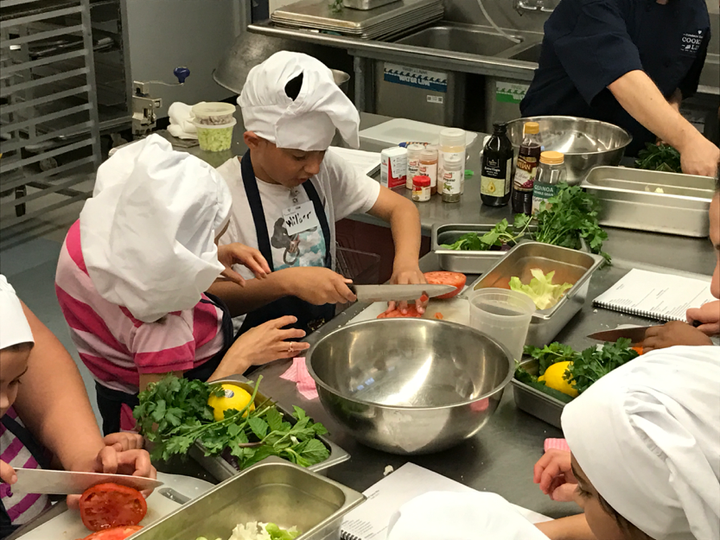
PepsiCo’s Dan Christenson (left) and Common Threads CEO Linda Novick O’Keefe (standing) introduce panelists (left to right) Kristen Rowe, Patrick McDermott, Paula Reichel and Signe Anderson.
For many of us, the first week of August feels like a pause in summer, a reminder to relish these last few weeks of sun and relaxed schedules. But for so many families across the country, summer months can be anything but a vacation. School has already been out for weeks and are still closed for several more, leaving children without access to daily nutrition and meals provided by school breakfast and lunch programs.
The USDA’s National School Lunch Program provides free and reduced-price meals for more than 30 million low-income children during the school year. Still, only one in seven of those same children receives healthy food over the summer.
The lack of access to healthy school meals, as well as healthy snacks and nutrition education provided by after-school programs, makes summer a dangerous time for these students. It often results in negative health and development outcomes for children, including weight gain and a “summer slide” in academic learning.
Wellness champions in the nation’s capital are working tirelessly to provide accessible, healthy summer food and nutrition education throughout the city. Health advocates in DC often serve as a model for the rest of the nation, leading by example for other nonprofits across the country to follow in implementing programs and services to feed and educate those underserved populations.
Common Threads recently convened a panel of these local thought leaders to discuss the state of public health in DC, exploring successes that can be replicated and scaled in other cities, as well as innovation solutions to the challenges still facing the district, such as improving food access in the city’s poorest districts and integrating nutrition education into the school day to improve health outcomes.
Food Access
“Obesity is a big issue that spikes during the summer because children and families who do not participate in summer meal programs often do not have access to healthy food,” said Signe Anderson, Senior Child Nutrition Policy Analyst for the Food Research and Action Center, a national anti-hunger organization that helps improve local access to federal nutrition programs to alleviate hunger.
Kristen Rowe, Nutrition Manager at District of Columbia Public Schools (DCPS), has also overseen an expansion of the district’s after-school and supper time meal programs, adding a third meal to the day to supplement what is already being offered by the school breakfast and lunch programs. Through a partnership with DC Hunger Solutions, free summer meals are provided at 44 sites to “any child who walks in off the street.”
“We had a lot of students eating lunch, but we knew there was that time between lunch and all the way to the next day at breakfast when kids weren’t getting food, so we tried to bolster that after-school supper meal time,” Rowe said.
The District also works with a program, Cafeteria Chefs, in which the lunchroom staff teach kids hands-on nutrition lessons in the classrooms. The students cook a meal together then sit down and eat as a class.
“Some schools in the district have started replicating some of those healthy recipes as part of their regular school lunches,” Rowe said. “Amazingly we’ve seen school lunch participation increase significantly on those days because kids recognize the foods they’ve already made in the classroom and it makes them want to eat it again.”
The Capital Area Food Bank (CAFB) is the region’s largest anti-hunger organization, reaching about 12 percent of the population with more than 46 million pounds of food each year. Paula Reichel, Chief of Staff for the Capital Area Food Bank and member of the DC Food Policy Council, explains, “In the 30-year history of the Food Bank, the driving force has always been about distributing as many pounds of food as possible, but not all pounds of food are created equal, and leafy greens don’t weigh very much,” Reichel said. “Now we’re looking specifically at how many pounds of fresh vegetables, and looking to embed more nutrition education into our programs so we can better evaluate the success of our intervention by seeing that behavior change.”
Partnerships with Joyful Food Market and Produce Plus have been successful in making fruits and vegetables more accessible, especially in vulnerable communities. Joyful Food Market offers free fresh produce to families in after-school farmer’s markets at 49 schools in Wards 7 and 8, the highest need areas of the city. Produce Plus provides vouchers to eligible citizens to redeem for a free $10 to spend specifically on fresh fruits and vegetables, going one step further than the many “double dollars” programs currently operating across the country, in which you must spend $5 to get a free $5 worth of groceries.
But as Common Threads DC Program Manager Patrick McDermott notes, access to healthy food is only half the battle.
“If you have a parent or an older child who walks into the grocery store and they see broccoli, but they don’t know what to do with it, they’re not going to buy it. That’s the reality.”
Nutrition Education
Nutrition education is the bridge that links healthy food access to actual consumption and longer lasting patterns of behavior change. Hands-on cooking classes and nutrition education lessons not only provide children with access to nutritious meals and snacks, but also teach them the knowledge and skills they need to form lasting healthy habits.
“After going through our programs, when a parent or child sees a vegetable like broccoli in a store, they not only know why it’s good for them and why it’s important to eat it, but they can actually go home and cook something with it that their family will enjoy,” McDermott said.

Children sharpen their knife skills while preparing a refreshing salad during a Common Threads Cooking Skills & World Cuisine class.
Children sharpen their knife skills while preparing a refreshing salad during a Common Threads Cooking Skills & World Cuisine class.
While programs like the ones mentioned above are doing incredible work, not everyone in the community knows about them. One way to increase awareness of these programs is to make nutrition a key component of the everyday curriculum, creating direct interventions that students, parents and educators will know about. DC has found this process difficult though, given the heavy burden already placed on the district’s teachers.
“It’s one of our main struggles because teachers are teaching toward the standardized tests, so asking them to do additional programming is a lot of stress and extra work for them,” Rowe said. “We need to be adaptable in the way that we provide nutrition education by finding those wellness champions like Common Threads or The Food Bank to come into the classroom so we’re not always depending on school staff.”
While these organizations already conduct after-school and summer programming and have the curriculum needed to bring nutrition into all of these classrooms, they too are limited by capacity as nonprofits. Therefore, schools and service organizations must collaborate to find creative solutions for program delivery.
“There is a lot of interest among teachers in being able to deliver the kind of nutrition education we are talking about,” McDermott said. “In the long term, we need to find a way to accommodate both standardized test prep and learning what a healthy plate looks like and how to make it. In the short term, we can enhance volunteer recruitment and engage non-traditional members of the school community like cafeteria workers or PTA members who may be interested in cooking, gardening and nutrition. These are untapped resources with major potential to help the district meet its wellness priorities during the school day.”
In addition to finding outside resources to assist the district in improving student health, individual schools need to communicate nutrition wellness as a priority from the top down.
“Principal and administrator buy-in is very important,” Reichel said. “When you see a school leader who really understands how the health and well-being of their students impacts their academic performance, and really prioritizes healthy food and nutrition education, then they will figure out how to make it work for the teachers.”
Especially over the summer, childhood hunger and nutrition is a national problem, but America’s capital is paving the way with creative solutions to address the issues of food access and nutrition education in the district’s most high priority areas. The efforts of these organizations in DC to improve student health prove that collaboration is the key to innovation, especially when resources are scarce.
“There are a lot of passionate people in DC that have been working on this for several years,” Anderson said. “What sets DC apart is the passion of different organizations, schools and the food bank, who are all very much involved in the process and work together because we all believe our kids deserve a better, healthier future.”
